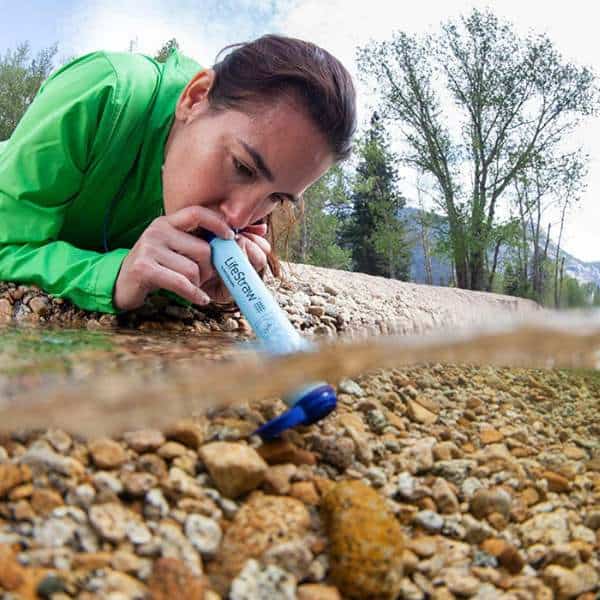Who Are Lifestraw and Sawyer?
LifeStraw is a brand under its parent company, Vestergaard. Vestergaard started its operation in 1994 and it’s not until 2005 that the LifeStraw brand became mainstream.
Over the years, the brand has supported numerous humanitarian initiatives across the globe – as we saw in the Lifestraw Personal review – mainly to provide safe drinking water.
Sawyer Mini was formed in 1984 to offer clean drinking water and protection against bugs such as mosquitoes.
After acquiring Coulston Products in 1999, the company started producing insect repellant products. They also produce the Sawyer line of water filtration.
As mentioned in our Sawyer Mini review, most of their water filters are a favorite to outdoor enthusiasts as they are specifically engineered for such activities.
Both the Sawyer mini and LifeStraw water filtration products have become a household name among home users and outdoor enthusiasts.
This is because the products offer exceptional filtration performance, are lightweight, and have longer longevity.
In this article, we look at the Sawyer Mini Water Filtration System and LifeStraw Personal Water Filter. Let’s see how they compare.
| Image | PRODUCT/ Features | Rating | |
|---|---|---|---|
Winner |
Sawyer MiniFilter Quality: 99.99% bacteria, protozoa, 100% microplastics Lifespan: 100,000 gallons of water (more than four years) Annual Replacement Cost: Nil $13.99+ for buying water pouches Capacity: 100,000 gallons Warranty: Lifetime Warranty Special Features: Hydration bladder |
|
|
 |
Lifestraw PersonalFilter Quality: 99.99% bacteria, parasites, microplastics, sand, dirt, cloudiness Lifespan: 100,000 gallons of water (more than four years) Annual Replacement Cost: Nil Capacity: 1,000 gallons Warranty: 3 years Special Features: Carrying case lanyard |
|
Sawyer Mini vs LifeStraw Water Filter
Filter quality
The Sawyer Mini is a versatile filter that keeps many contaminants at bay. For one, it removes up to 99.99% of bacteria from tap or river water.
This includes E.coli and cholera. This ensures you can enjoy your hiking experience without worrying about visiting a doc after the pleasant adventure.
What’s more, it removes 99.99% of protozoa and 100% of microplastics.
This is done through the micron filtration system that traps contaminants as the water flow through the filter.
The 0.1-micron filter ensures that no bacteria or protozoa reach your mouth. Given the small size, avoid using it on muddy water as this might clog them.
And to ensure you only get nothing but the best portable water filter, it is certified by several bodies such as Aquadiagnostics and Envirotek Laboratories.
The filter, therefore, meets the Environmental Protection Agency requirements. As such, using the Sawyer mini filter guarantees optimal results.
Like the Sawyer Mini, the LifeStraw filter removes 99.99% of bacteria, parasites, and microplastics. However, it does not remove viruses, chemicals, lead, and PFAs.
On its part, it has a 0.2-micron filter, larger than the Sawyer’s 0.1 micron.
While it captures bacteria, parasites, and microplastics, its efficiency is hampered since the pores are large.
That said, the filter can filter up to 1000 gallons of water before replacement. This is enough to last you for years. Besides, the filter does not come with an expiry date.
As you can see, comparing LifeStraw vs Sawyer mini, both will keep you safe from illness-causing organisms and contaminants.
The Sawyer Mini filter however, takes the day as it can filter up to 100% of microplastics.

Design and model
The Sawyer mini and LifeStraw water filters both come in minimalistic and lightweight designs. This allows you to carry either around with you mitigating the need for a water bottle.
If you are involved in outdoor activities such as hiking and camping, these brands are a must-have.
Another striking resemblance is their blue color that almost feels like clean water at first glance.
Both are also easy to use and maintain since there are minimal parts that need assembling. For the Sawyer mini, you only need to screw the filter to the water storage pouch, while the LifeStraw enables you to use it as it is.
And as expected, they are durable since they are intended for outdoor activities.
The plastic used on both is BPA-free, meaning that you are less susceptible to compounds that might alter your hormones or increase estrogen.
The LifeStraw is lighter, weighing 45 grams compared to the 100 grams Sawyer mini water filter. For both, you can easily fit them in your backpack as you go hiking.
The Sawyer mini water filter comes with a squeeze pouch that saves you the need for a water bottle which can be annoying carrying around.
The LifeStraw lacks this feature, and as such, you need to drink straight from the water source.
Once you fill the water storage, you only need to connect it to the filter. And with the provided drinking straw, you can enjoy your water.
Another unique feature of the Sawyer Mini is how enclosed the filter is. This mitigates the chances of damage and also the entry of pathogens and germs.
This means you only get safe to drink water.
The LifeStraw comes with a lanyard that allows you to hang it around your neck safely. This reduces the chances of losing it.
The Sawyer mini filter outshines its competitor since it provides you a pouch that you can store water in.
Flow rate/Capacity
Well, this is the amount of water that a filter can filter within a set time. If you don’t want to spend hours waiting, then a filter with a higher flow rate is what you need.
Conversely, if you want cleaner water, then a filter with a slower flow rate is what you need.
The Sawyer Mini comes with a 1.1 liter/minute flow rate, while the LifeStraw boasts of 1.7liters per minute.
From this data, it is clear that Sawyer has a slower rate than LifeStraw, which is ideal for the optimal removal of toxins and contaminants.
On the other hand, LifeStraw makes the cut for those looking for quick thirst-quenching.
So, which filter wins in this Sawyer mini vs LifeStraw comparison? Well, the Swayer mini filter carries the day.
Due to the slow flow rate, thanks to the 0.1-micron filter, there’s greater interaction between the filter and the toxins. This means that the filter will remove at least 99% of the toxins. As a result, you get safer water to drink regardless of the water source.
Another reason is that the finer granules in the Swayer filter, it can easily remove bacteria, parasites, protozoa, and microplastics. In fact, it removes 100% microplastics.

Certification
The Sawyer Mini and the LifeStraw filters meet international standards and are approved by relevant bodies.
For LifeStraw, it became B Corp certified on April 5, 2021. This means that it is geared towards providing means for safe drinking water and championing accountability, transparency, and sustainability in the industry.
It is also ISO certified, meaning that it follows all guidelines in the manufacture of the LifeStraw filter.
It also meets the National Sanitation Foundation (NFS) and Environmental Protection Agency (EPA) requirements.
As such, it is scientifically identified as a product that can capture parasites and bacteria.
Sawyer mini, on the other hand, ensures that the filter undergoes independent tests from relevant authorities. This has enabled it to be certified by Envirotek and Aguadiagnostics laboratories.
This means that the filter can provide clean and safe drinking water fetched from contaminated sources.
It also meets the Environmental Protection Agency (EPA) removal requirements.
It is no doubt that in the Sawyer mini vs LifeStraw comparison, both filters do put much effort into ensuring that they meet the certification requirements.
Therefore, it is a tie in this section.
Lifespan and annual maintenance
Now, both LifeStraw and Sawyer mini can offer you services for more than two years, given the quality of the filters.
The LifeStraw filter lifespan is capped at 1,000 gallons or 4,000 liters. Well, how long can you take to finish 4,000 liters?
My perfect guess, years!
The filter can provide you clean drinking water for more than two years. And the best part, you don’t need to replace any of its components.
What you’d buy – and this would last you for years, too – is a carry case that will cost you a mere $8.99.
Besides, it can withstand accidental drops as you bike or hike around thanks to the sturdy plastic construction.
What of the Sawyer mini water filter?
It has a longer lifespan of 100,000 gallons or approximately 378541 liters.
This means you can use it for many years without the need to replace it.
To put it in an optimal state, you just need to backwash and sanitize it after a few days of use. This only affects 1% of its flow rate, showing how sturdy the filter membrane is.
All you’ll need to buy once in a while is the water pouch that will cost you $13.61.
From the comparison, we can see that the Sawyer mini outshines LifeStraw when it comes to lifespan. Their annual maintenance may vary since the filters themselves can go for years without the need for replacement.
Warranty
The Sawyer mini filter comes with a lifetime warranty. As long as there’s a defect within the 100,000 gallons period, then you can contact LifeStraw for a replacement.
Note that the warranty only covers the filter and not the accessories such as the straw and water storage pouch.
LifeStraw filter comes with a three-year warranty that only covers material and workmanship defects. It does not cover damage from impacts and drops.
Neither does it cover for a lost filter.
The Sawyer mini wins since it has a more extended warranty.
Stand out features
While both the Sawyer and LifeStraw filters offer ideal performance, there are distinctive features in both. Let’s find out.
- Lifetime warranty: it’s hard to come by filters that offer you a lifetime warranty, but this is what you get from the Swayer filter. This ensures that if it develops defects years after buying, you can replace it for free.
- 100,000 gallons capacity: now, this is what makes the Sawyer mini standout. This means you can use it for many years without replacing, unlike LifeStraw that has a lifespan of 4,000 liters.
- Water pouch: Sawyer filter comes with a water pouch that allows you to store water for on-the-go drinking.
- Carrying pouch: you can buy a carrying pouch for your LifeStraw filter. Sawyer mini does not offer this.
Which Portable Filter Is Better? Lifestraw or Sawyer Mini?
Both filters will arguably allow you to enjoy safe drinking water thanks to their filtration capabilities. But each is well-suited for different situations. Let’s find out.
+ You don’t have extra space in your bag. You can hang it around your neck thanks to the provided lanyard.
+ You want a quick water filtration system. It filters up to 1.7 liters per minute, making it ideal for quick stops at a water source.
+ You don’t want to have it for a lifetime. With a lifespan of 1,000 gallons, you can replace it within five years.
+ You want safer and cleaner drinking water. Its filtration method is more robust compared to LifeStraw.
+ You are going hiking or camping in places without water sources within reach. The pouch can store enough water for a few hours.
+ If you don’t want to carry water bottles through your backpacking trip.

